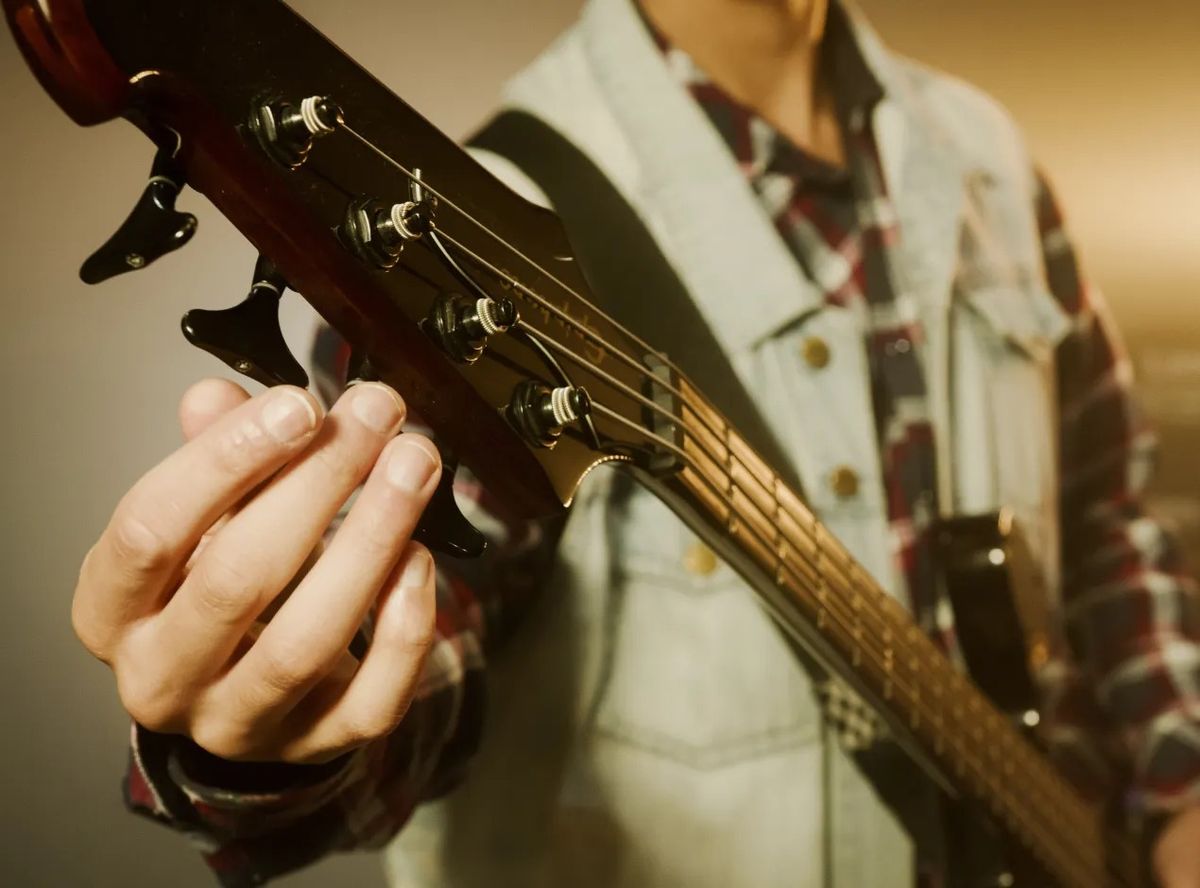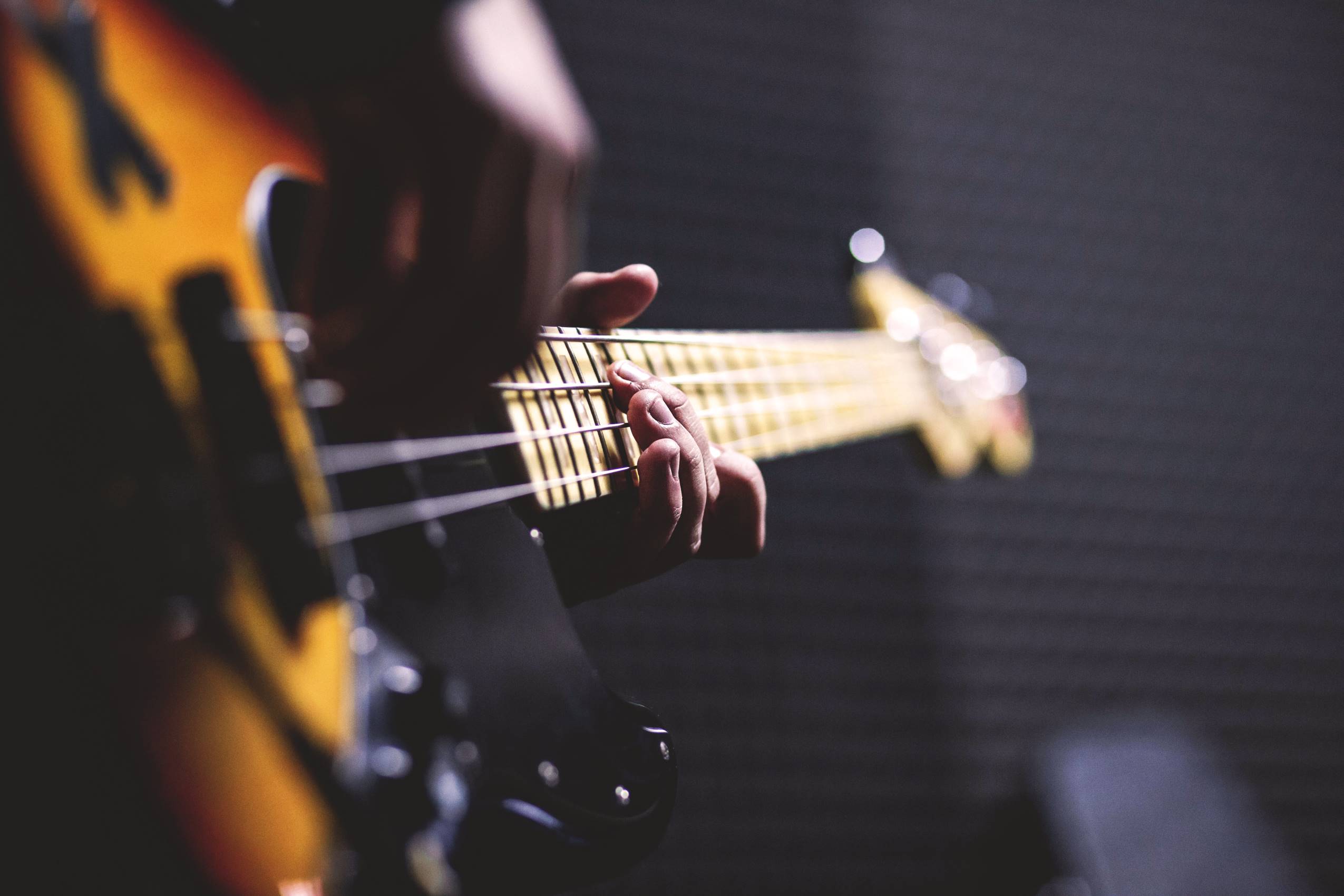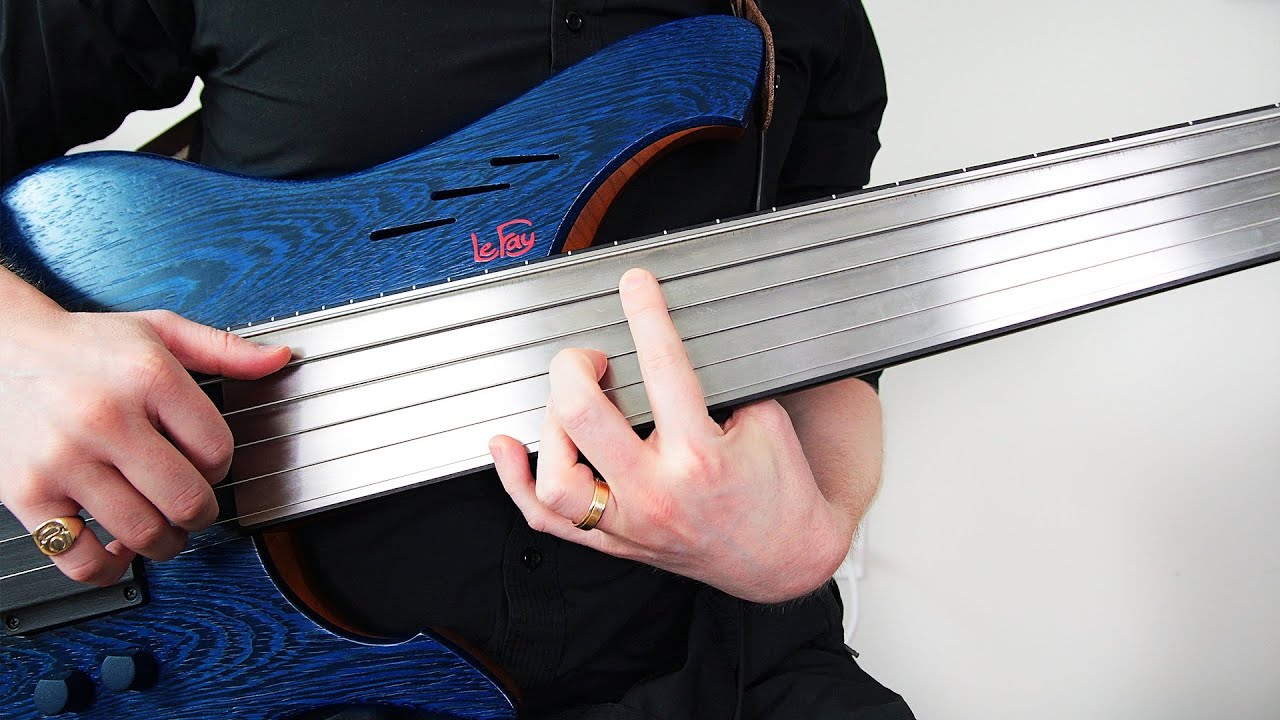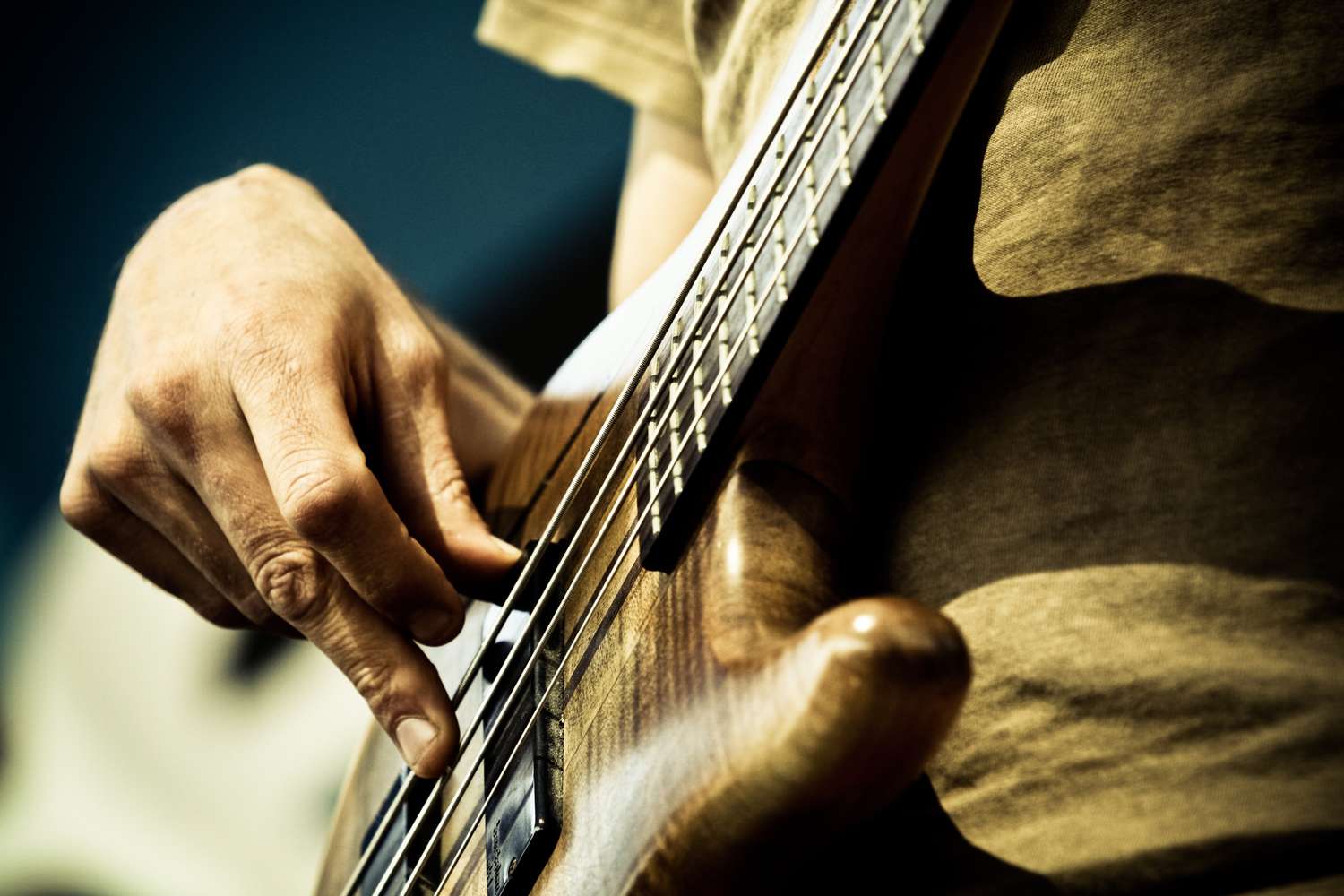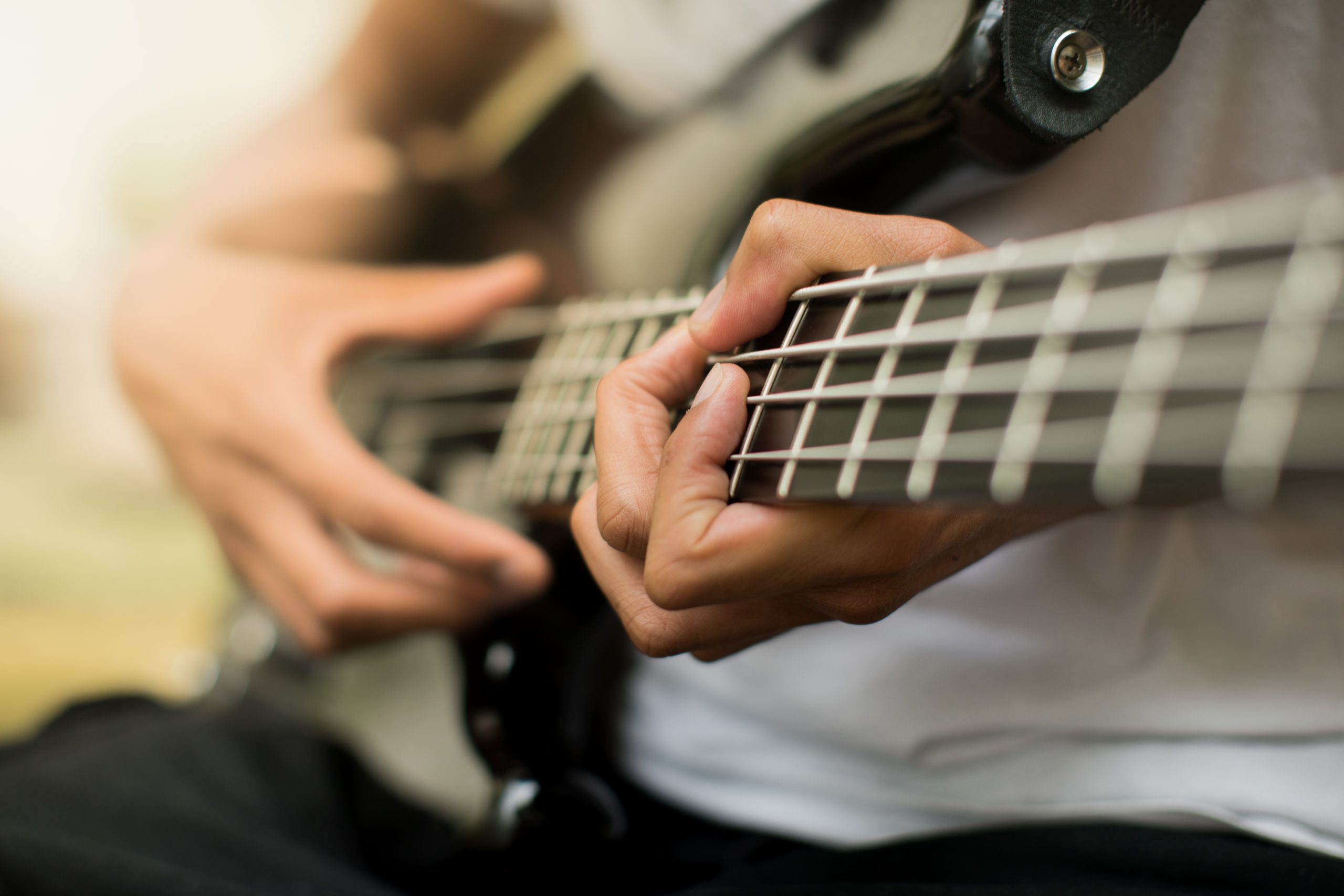Home>Instruments>Bass>How To Play The Double Bass


Bass
How To Play The Double Bass
Modified: January 22, 2024
Learn how to play the double bass with our comprehensive guide. Master the techniques and unleash your musical potential with our expert tips and tutorials.
(Many of the links in this article redirect to a specific reviewed product. Your purchase of these products through affiliate links helps to generate commission for AudioLover.com, at no extra cost. Learn more)
Table of Contents
- Introduction
- Getting Started with the Double Bass
- Essential Techniques for Playing the Double Bass
- Understanding the Double Bass Strings
- Proper Posture and Bowing Techniques
- Basic Music Notation for Double Bass Players
- Developing Fingerings and Hand Positions
- Tips for Solo and Ensemble Performances
- Maintaining and Caring for Your Double Bass
- Conclusion
Introduction
The double bass is a magnificent instrument that adds depth and richness to any musical ensemble. Known for its deep, resonant tones, the double bass plays a crucial role in providing the foundation and rhythm in various genres such as classical, jazz, and popular music.
Whether you’re a beginner or an experienced musician looking to explore a new instrument, the double bass offers a unique and rewarding playing experience. However, mastering the double bass requires dedication, practice, and a solid understanding of essential techniques and concepts.
In this article, we will guide you through the fundamentals of playing the double bass, including proper technique, understanding the instrument’s strings, posture and bowing techniques, music notation, fingerings and hand positions, performance tips, and instrument maintenance. By the end, you’ll have a solid foundation to progress in your double bass journey.
Before we dive into the techniques and intricacies of playing the double bass, let’s take a moment to appreciate the instrument’s history. The double bass, also commonly referred to as the upright bass or contrabass, has its roots in the 16th century, evolving from the violone, a large instrument from the Renaissance period. Over time, the double bass gained prominence in orchestras and ensembles, becoming an indispensable part of the bass section.
As you embark on your double bass journey, remember that learning any musical instrument is a process that requires patience and persistence. Take the time to familiarize yourself with the instrument, develop good habits, and above all, enjoy the journey of creating beautiful music.
Getting Started with the Double Bass
Before diving into playing the double bass, it’s important to ensure that you have the right instrument and equipment. The double bass is a large and heavy instrument, so make sure you have a suitable and sturdy instrument stand or case to safely hold it when not in use. Additionally, you’ll need a comfortable and adjustable bass stool or chair to support your playing posture.
When it comes to selecting a double bass, there are various options available. You can choose between an acoustic double bass or an electric upright bass. Acoustic double basses produce a warm and traditional sound, making them ideal for classical and jazz music. On the other hand, electric upright basses offer a more versatile and portable option, with the ability to amplify the sound for live performances or recording.
Once you have your double bass set up, it’s time to familiarize yourself with the instrument’s anatomy. The double bass consists of several key components, including the body, neck, fingerboard, bridge, strings, and the bass bow. Spend some time examining each part of the instrument to understand how they contribute to creating sound and how to properly handle and care for them.
Before attempting to play, it’s crucial to develop good posture and body mechanics. Standing or sitting with proper posture not only improves your technique but also prevents fatigue and potential injuries. Stand or sit up straight, with your feet shoulder-width apart. Keep your shoulders relaxed, and maintain a balanced distribution of weight between both feet.
Next, familiarize yourself with the correct way to hold the bass bow. Grasp the bow near the frog (the end of the bow that is closer to the strings) with a relaxed and slight curved grip. The hair of the bow should be facing upwards, and your thumb should rest lightly on the bow’s thumb grip. Be cautious not to grip the bow too tightly, as it will restrict your control and tone production.
Now that you have the basics down, it’s time to start plucking the strings. Place your fingers on the strings directly above their respective frets, and use your thumb to pluck the strings downward. Start by playing one string at a time, gradually moving up and down the neck to get comfortable with different notes and finger placements.
Remember, practice makes perfect. Dedicate regular practice sessions to improve your technique and build finger strength. Start with simple exercises and gradually progress to more complex melodies and scales. Don’t be discouraged by initial challenges – with time and dedication, you’ll begin to develop speed, accuracy, and an ear for the instrument’s unique sound.
In the next section, we’ll explore essential techniques for playing the double bass, including bowing techniques, understanding the instrument’s strings, and basic music notation.
Essential Techniques for Playing the Double Bass
Mastering the essential techniques for playing the double bass is key to unlocking its full potential. The following techniques will help you develop a solid foundation and improve your overall playing skills.
One of the fundamental techniques in double bass playing is bowing. The bow is an essential tool that allows for sustained notes, dynamic changes, and expressive playing. Practice maintaining a relaxed grip on the bow and using the weight of your arm to produce a smooth and even sound. Experiment with different bowing styles, such as legato (smooth and connected), staccato (short and detached), and spiccato (bouncing off the strings).
Another important technique is pizzicato, which involves plucking the strings with your fingers. To achieve a clear and resonant sound, make sure to pluck the string with the pads of your fingers, rather than the tips. Practice pizzicato on each string, focusing on producing a consistent tone and controlling the duration of each note.
When it comes to finger positioning, the double bass follows a different approach compared to other string instruments. Instead of using fixed frets, you will develop a sense of hand positions and fingerings based on the approximate locations of certain intervals. Start by placing your index finger in the first half of the string length for the lowest note, and then use your other fingers to produce different pitches. This technique, known as “thumb position,” allows for reaching higher notes on the fingerboard.
In addition to finger placement, it’s crucial to develop strong and precise intonation. Intonation refers to playing the correct pitch in tune. Use an electronic tuner or piano reference to train your ear and ensure accurate intonation. Regularly practice scales and melodic exercises to improve your intonation skills across different positions and string combinations.
As you progress in your double bass journey, you’ll encounter various playing styles and genres. Familiarize yourself with different musical genres such as classical, jazz, and popular music, and explore their specific playing techniques and repertoire. This will expand your versatility as a double bass player and open up opportunities for collaboration with other musicians.
Besides technique, it’s important to develop a strong sense of rhythm and timing. The double bass plays a crucial role in providing the rhythmic foundation of a musical ensemble. Practice playing along with a metronome or backing tracks to improve your sense of timing and develop a solid groove.
Lastly, don’t forget to take care of your instrument. Regularly clean and condition the strings, polish the fingerboard, and check for any signs of wear or damage. Proper instrument maintenance ensures optimal performance and longevity.
By consistently practicing these essential techniques and incorporating them into your playing, you’ll develop the skills and confidence to play the double bass with precision and expressiveness.
In the next section, we’ll delve deeper into understanding the double bass strings and their characteristics.
Understanding the Double Bass Strings
The strings of the double bass play a crucial role in shaping the instrument’s sound and character. Understanding the different types of strings and their characteristics will help you achieve the desired tone and playability.
Traditionally, double bass strings were made from gut, which produces a warm and rich sound ideal for classical and orchestral music. Gut strings offer a wide range of tonal possibilities, from soft and mellow to powerful and resonant. However, they require more maintenance and are sensitive to changes in temperature and humidity.
Modern advancements have led to the development of steel-core strings, which are more durable and stable compared to gut strings. Steel-core strings produce a bright and focused sound, making them suitable for genres such as jazz, rock, and pop. They also provide more projection and sustain, allowing the bass to cut through a mix in amplified settings.
In addition to gut and steel, there are also synthetic-core strings available on the market. Synthetic-core strings aim to combine the tonal characteristics of gut strings with the stability and longevity of steel-core strings. They offer a variety of options that cater to different playing styles and preferences.
When selecting strings for your double bass, consider factors such as playing style, musical genre, personal preference, and budget. Experimenting with different string brands and tensions will help you find the best fit for your playing style and desired tone.
It’s important to note that changing strings can have a significant impact on the sound and playability of the instrument. When replacing strings, make sure to follow the manufacturer’s recommendations for installation and tuning. Give the strings time to settle and stabilize before making any adjustments.
Regular maintenance and care of your double bass strings are essential to ensure optimal performance and longevity. Wipe down the strings after each playing session to remove rosin buildup and prevent corrosion. Use a soft cloth or string cleaner specifically designed for double bass strings.
It’s also advisable to periodically check the condition of the strings for signs of wear, such as fraying or unraveling. Replace any damaged or worn-out strings promptly to maintain consistency in sound and playability.
Remember to tune your double bass regularly to maintain proper tension and tonal balance. Use a reliable electronic tuner or tuning fork for accurate results.
By understanding the characteristics of different double bass strings and taking care of them, you’ll be able to achieve the desired tone and playability that complements your musical style and enhances your performance.
In the next section, we’ll delve into proper posture and bowing techniques for playing the double bass.
Proper Posture and Bowing Techniques
Having proper posture and mastering bowing techniques are essential for playing the double bass effectively and producing a desirable tone. Paying attention to your posture and bowing technique will not only enhance your performance but also prevent discomfort and injuries.
When it comes to posture, it’s important to maintain a balanced and relaxed position. Whether you’re standing or sitting, ensure that your back is straight and your shoulders are relaxed. Distribute your weight evenly on both feet or buttocks, depending on your position.
If you choose to sit while playing, use an adjustable and comfortable bass stool or chair. Adjust the height so that your knees are at a right angle and your feet are firmly grounded. While standing, use a well-balanced instrument stand or a supportive shoulder rest to offer stability.
Next, let’s dive into the essential techniques for proper bowing. Hold the bow in a relaxed and loose grip, using all of your fingers without gripping too tightly. Place your thumb slightly bent on the grip of the bow, allowing for flexibility and control.
Start your bow stroke by positioning the bow at a comfortable distance from the bridge and parallel to the strings. Begin moving the bow with your forearm, keeping your wrist flexible and using the weight of your arm to apply pressure on the strings. Avoid using excessive force or tension, as it can produce a harsh or scratchy sound.
Experiment with different bowing techniques to create a variety of sounds and articulations. The most common bowing technique is the “full” or “long” bow, where you use the entire length of the bow in a smooth and steady motion. This technique allows for a sustained and connected sound.
Another technique to explore is the “short” or “staccato” bowing, which involves using shorter bow strokes and releasing the pressure on the strings quickly. This technique produces a sharp and detached sound, ideal for playing rhythmic passages or accentuated notes.
As you become more comfortable with basic bowing techniques, you can explore advanced techniques such as spiccato (bouncing the bow off the strings), sautillé (controlled bouncing bow strokes), and tremolo (rapid back-and-forth bowing).
Pay attention to the bow’s contact point on the strings. Experiment with different contact points, closer to the bridge for a brighter and more focused sound, or closer to the fingerboard for a softer and warmer sound.
While playing, make sure to maintain an even bow speed and pressure to achieve consistency in tone and volume. Practice control and precision by starting with slow and deliberate bow strokes, gradually increasing the speed as you become more comfortable.
Proper posture and bowing techniques are the foundation for producing a beautiful and expressive sound on the double bass. Take the time to develop and refine these techniques, as they will greatly enhance your playing and musicality.
In the next section, we’ll explore basic music notation for double bass players.
Basic Music Notation for Double Bass Players
Understanding music notation is crucial for any musician, and double bass players are no exception. Reading and interpreting music notation allows you to accurately recreate the composer’s intentions and bring the music to life. Here, we’ll cover some basic concepts of music notation that every double bass player should be familiar with.
The staff is the foundation of music notation. It consists of five horizontal lines and four spaces, with each line and space representing a specific pitch. The double bass is notated in bass clef, traditionally marked with an F-clef at the beginning of the staff.
Notes are the building blocks of music notation. They are represented by ovals placed on the lines and spaces of the staff. The position of the note on the staff indicates the pitch, with lower notes placed lower on the staff.
The duration of notes is indicated by the shape of the note head and additional symbols. A solid note head represents a quarter note, while a hollow note head represents a half note. Flags or beams attached to the note stems indicate shorter note durations, such as eighth notes, sixteenth notes, and so on.
Rests are symbols used to indicate periods of silence within the music. They have shapes and duration values that correspond to their note counterparts. Rests allow for proper pacing and rhythmic accuracy when reading sheet music.
Dynamics markings provide instructions for the volume and intensity of the music. Common dynamic markings include pianissimo (very soft), piano (soft), mezzo piano (moderately soft), mezzo forte (moderately loud), forte (loud), and fortissimo (very loud). These markings guide you in interpreting the music’s dynamics and conveying the desired expression.
Articulations and phrasing marks help clarify how each note should be played. Staccato dots indicate short and detached notes, while legato lines indicate smooth and connected notes. Slurs are curved lines that group notes together, indicating a smooth and connected phrase.
Double bass players also encounter various techniques and markings specific to their instrument. These may include pizzicato (Pizz.), where you pluck the strings with your fingers instead of using the bow, and col legno (with the wood), where you strike the strings with the wooden part of the bow to create a unique sound.
Sheet music also provides information about key signatures, time signatures, tempo markings, and other important details that give context to the music. Familiarize yourself with these symbols and notations to fully comprehend the piece you’re playing.
With regular practice and exposure to different musical compositions, you’ll become more fluent in reading and interpreting music notation. Take the time to study the score, analyze the markings, and understand the musical structure. This will greatly enhance your ability to interpret and perform the music accurately.
In the next section, we’ll delve into developing fingerings and hand positions for playing the double bass.
Developing Fingerings and Hand Positions
Developing proper fingerings and hand positions is essential for playing the double bass with precision and ease. Knowing where to place your fingers and how to position your hand on the fingerboard will greatly enhance your technique and facilitate fluid playing. Here, we’ll explore some key aspects of developing fingerings and hand positions for the double bass.
When it comes to fingerings, the double bass differs from other string instruments that have fixed frets. Instead, finger placement on the fingerboard is based on hand positions and approximate locations of intervals. Developing a solid foundation in fingerings involves understanding the relationship between your hand, finger span, and the distance between notes.
Begin by placing your index finger on the fingerboard, approximately halfway between the nut and the first fret. This position allows you to produce the lowest note on each string. As you progress, experiment with hand positions on the fingerboard to access higher notes. One common technique is the “thumb position,” where your thumb reaches over the neck to support the higher fingerings.
Developing finger strength and dexterity is crucial for playing the double bass effectively. Regular exercises that involve playing scales, arpeggios, and melodic patterns will help strengthen your fingers and improve coordination. Practice these exercises in various hand positions to develop flexibility and accuracy across the fingerboard.
When placing your fingers on the fingerboard, use the pads of your fingers to press against the strings. This allows for a solid and clear connection with the strings. Avoid pressing too hard or too lightly, as it can affect the quality of the sound. Take time to develop a sense of finger pressure that allows for optimal sound production without unnecessary tension.
Maintaining proper hand positions is crucial for playing with ease and preventing strain or injury. The hand position is determined by the angle and curvature of the wrist, as well as the position of the fingers on the fingerboard. Keep your hand relaxed and naturally curved, allowing for free movement and flexibility.
As you move up the fingerboard, your hand position may need to adjust to the changing distances between notes. Be mindful of maintaining a relaxed hand position, even when reaching for higher notes on the fingerboard. Frequent practice in various hand positions will help you develop muscle memory and make transitions between positions smoother.
Developing fingerings and hand positions is an ongoing process that requires consistent practice and attentive listening. As you play different musical pieces and exercises, pay attention to the sound and feel of different fingerings and hand positions. Strive for accuracy, clarity, and a comfortable playing experience.
Experiment with different fingerings and hand positions to find what works best for you. What is most important is finding a balance between technical precision and musical expression. With time and practice, you’ll become more confident in navigating the fingerboard and playing with ease.
In the next section, we’ll provide tips for solo and ensemble performances on the double bass.
Tips for Solo and Ensemble Performances
Whether you’re performing as a soloist or as part of an ensemble, there are specific considerations and techniques to keep in mind to deliver a successful and captivating performance on the double bass. Here, we’ll explore some valuable tips to enhance your solo and ensemble performances.
1. Preparation: Proper preparation is essential for any performance. Practice regularly and dedicate time to rehearsing specific pieces or sections that require extra attention. Familiarize yourself with the musical structure, dynamics, and phrasing to ensure a confident and expressive delivery.
2. Communication and Listening: In ensemble performances, actively listen to other musicians and communicate with them during rehearsals and performances. Pay attention to cues, dynamics, and nuances that will enhance your ability to blend in and provide a solid foundation for the ensemble. Be responsive to the conductor and fellow musicians to maintain a cohesive performance.
3. Technique and Expression: Focus on both technical precision and expressive musicality. Pay attention to intonation, rhythm, and articulation. Strive for a balanced tone, and experiment with different bowing techniques and fingerings to bring out the desired expression in the music. Practice dynamic contrasts to add depth and emotion to your performance.
4. Stage Presence: Engage the audience with your stage presence. Maintain good posture, make eye contact, and project confidence. Use appropriate body movements and gestures to enhance the musical interpretation and captivate the listeners.
5. Musical Interpretation: Develop a deep understanding of the musical style and context of the pieces you perform. Study different interpretations by renowned musicians to gain inspiration and insight. Interpret the music in a way that reflects your unique musical voice while remaining faithful to the composer’s intentions.
6. Ensemble Dynamics: In ensemble performances, be aware of the dynamic balance with other instruments. Adjust your playing style and volume to ensure a harmonious and well-balanced sound. Collaborate with other musicians to create a cohesive and unified performance.
7. Musical Communication: Use expressive and intentional phrasing to communicate the musical ideas to the audience. Shape the music with dynamic contrasts, subtle accents, and well-executed articulations. Aim to convey the emotional content of the piece and connect with your listeners on a deeper level.
8. Stage Logistics: Consider the logistics of your performance, especially if you’re playing in a large ensemble or in a concert setting. Be aware of your positioning on stage, page turns, and any necessary instrument adjustments between pieces. Communicate with the conductor and fellow musicians to ensure a smooth flow of the performance.
9. Adaptability: Be prepared to adapt to different performance settings and situations. Whether it’s a solo recital, chamber music, or orchestral performance, adjust your playing style and dynamics accordingly. Be flexible and open to feedback and suggestions from colleagues and musical directors.
10. Enjoy the Moment: Lastly, remember to enjoy the experience of performing. Embrace the joy of sharing music with others and the opportunity to express yourself through your instrument. Connect with the emotions and stories behind the music, and let the passion and love for the art form shine through in your performance.
By implementing these tips, you’ll be well-equipped to deliver memorable and engaging performances as a soloist or ensemble player on the double bass.
In the next section, we’ll explore essential tips for maintaining and caring for your double bass.
Maintaining and Caring for Your Double Bass
Maintaining and caring for your double bass is crucial to ensure its longevity and optimal performance. Here, we’ll provide some essential tips for taking care of your instrument.
1. Storage: When not in use, it’s important to store your double bass properly. Keep it in a secure and stable location away from direct sunlight, extreme temperatures, and excessive humidity. Use a suitable case or instrument stand designed specifically for double basses to protect it from accidental damage.
2. Cleaning: Regularly clean your double bass to remove rosin buildup and oil or dirt that may accumulate on the instrument’s surface. Gently wipe the instrument with a soft, lint-free cloth, and avoid using any harsh chemicals or abrasive materials.
3. Fingerboard Care: The fingerboard is a critical part of the instrument, and proper care is essential to maintain optimal playability. Clean the fingerboard with a soft cloth after each playing session to remove oils and sweat. Use a fingerboard conditioner or a small amount of mineral oil to keep the wood moisturized and prevent it from drying out.
4. String Care: Regularly inspect your strings for signs of wear or damage, such as fraying or unravelling. Replace any worn-out or damaged strings promptly to maintain consistent sound quality. Additionally, wipe down the strings after each playing session to remove rosin buildup and extend their lifespan.
5. Bow Care: Take care of your bow by loosening the hair after each use to retain its elasticity. Avoid touching the hair with your fingers as the oils from your skin can affect the friction and grip. Once a month, lightly apply bow rosin to the hair to maintain optimal bowing performance.
6. Adjustments and Maintenance: Regularly check your double bass for any signs of wear, cracks, or loose fittings. If you notice any of these issues, consult a professional luthier or instrument technician for the necessary repairs. Additionally, periodic adjustments to the soundpost, bridge, and tailpiece may be required to maintain the instrument’s optimal playability.
7. Climate Control: Changes in temperature and humidity can affect the structure and sound quality of your double bass. It’s essential to keep the instrument in a stable environment. Consider using a humidifier or dehumidifier to control the humidity level and protect the wood from swelling or drying out.
8. Transportation: When transporting your double bass, ensure it is properly protected. Use a padded bass bag or hard case designed for transportation to prevent any potential damage or accidents. Secure the instrument with straps or cushioning to minimize movement during transport.
9. Regular Inspections: Take the time to inspect your double bass regularly for any structural or functional issues. Look for cracks, open seams, loose or jutting pieces, or any signs of wear. Promptly address any concerns by consulting a qualified instrument repair professional.
10. Professional Maintenance: Schedule regular maintenance with a professional luthier or instrument technician. They can perform necessary adjustments, cleanings, and repairs to keep your double bass in optimal playing condition. A professional’s expertise and knowledge are invaluable in preserving and enhancing your instrument’s performance.
By following these maintenance and care tips, you will ensure that your double bass remains in excellent condition and retains its sound quality for years to come.
In the next section, we’ll conclude our article on playing the double bass with a summary of the key points covered.
Conclusion
Playing the double bass is a captivating and rewarding journey that requires dedication, practice, and a solid understanding of essential techniques. Throughout this article, we have explored various aspects of playing the double bass, including getting started, essential techniques, understanding strings, proper posture and bowing techniques, music notation, fingerings, performance tips, and instrument maintenance.
From selecting the right instrument and equipment to developing proper hand positions and fingerings, each step contributes to your growth as a double bass player. Learning to read and interpret music notation, mastering bowing techniques, and understanding the characteristics of different strings are essential for creating a rich and expressive sound.
Whether you’re performing as a soloist or as part of an ensemble, implementing tips for solo and ensemble performances will enhance your stage presence, communication, and overall musicality. Additionally, maintaining and caring for your double bass is crucial to ensure its longevity and optimal performance.
Remember, learning any musical instrument, including the double bass, is a continual process. It requires patience, persistence, and consistent practice. Embrace the challenges, celebrate small victories, and enjoy the journey of creating beautiful music with this remarkable instrument.
By following the guidance provided in this article, you’ll develop a strong foundation and the necessary skills to play the double bass with precision, expressiveness, and versatility. Whether you’re performing in a concert hall, a jazz club, or a recording studio, your love for the instrument and dedication to mastering it will shine through in your performances.
So, pick up your double bass, practice diligently, and let the deep and resonant tones of this magnificent instrument inspire and captivate both yourself and your audience. Enjoy the fascinating world of double bass playing!




